2004 diary
Mon Dec 20
The weather forecast said it would be clear at the pre-dawn and I got up
at 2:45am. Great sky! I changed my clothes and went out but it clouded before
I set off my carfs engine.
I waited till 3:40am in my bed but in vain.
Sat Dec 18
There so many fine days even in December in this year. Usually we have few
clear days in this month.
The transparency was pretty good at this pre-dawn. Tsutomu Seki mentioned
about the counterglow many times on his web page, which he saw in his naked
eye. I remembered it and tried to see it before the comet hunting session.
Yes, I could observe it around Auriga and Gemini.
During searching session I identified a couple of dozens of nebulae and
clusters. NGC4038 and 4039, the Ring Tail Galaxy, in Corvus were among them.
I knew that 14 th magnitude supernova appeared in NGC4038 that was discovered
by L. A.G. Monard in South Africa. However, during my searching session I
completely forgot it.
At 5am thin cloud covered most of the sky and I trained my telescope on
the north where there was a small gap in the cloud.
Tue Dec 14
At 3:40am I have arrived at the observing site near the top of the hill.
The sky was extremely clear! Just after I began to assemble my 18h telescope
a mass of dense fog was formed in the south in the valley. It grew rapidly
and approached me.
Ten minutes later my telescope and I were completely wrapped in a dense
fog. Nevertheless, I continued assembling the telescope. Twenty minutes later
fog began to dissipate and stars twinkled again.
I mainly swept Canes Venatici and Bootes. I wondered if there are so many
galaxies around here; I caught many 14 th magnitude galaxies at this pre-dawn!
Fri Dec 10
I caught more than a dozen of galaxies and several globular clusters in
this morning. I enjoyed comet hunting under the very clear sky and trained
my telescope mainly in Coma Berenices, Virgo and Bootes. It was not very cold.
Some of the galaxies were 13 th magnitude and the most impressive one among
them was NGC5248. It is located in Bootes and I recognized its spiral structure
at a glance!
In the latter half of the searching session, I could see beautiful scenery.
The crescent moon with earthlight rose with Mars and Venus. This reminded
me that I saw similar situation one month ago; the crescent moon was situated
just in the middle of Jupiter and Venus and they rose almost together.
I do not know the reason why but the moon gives me peace of mind.
Fri Dec 3
I have overslept this morning! I woke at 5am when the twilight began.
I thought the alarm clock had been set at 3am but probably I forgot to turn
it on. It must have been clear sky through the night that is valuable in
this season here in Niigata.
It was still fine in the evening and I went to comet hunting after sunset.
I began to search from near Altair. I caught some star clusters and NGC6956,
a galaxy in Delphinus , with a magnitude of 12.3 and a diameter of about
1f. It looked like a star at a first glace but my eye responded to very faint
halo around the stellar nucleus in the light polluted background.
After the comet searching session I observed C/2004 Q2 Machholz that had
just risen from the holizon with 8x50 binocular.
Tue Nov 23
Comfortable searching under the clear sky!
It has been bad weather for two weeks. I got tired from putting everything
in order after the earthquake. Everything began to recover as usual and
the pleasant sky sweep in this morning made me cheerful.
First, I observed C/2004 Q2 Machholz at an altitude of 10 degrees that
could be seen with 5cm finder. Then, I began to comet hunting at 3:48am
from ENE toward NE. I caught 3 globular clusters and 26 galaxies during
todayfs session. I could not have identified all of them without a digital
setting circle. NGC4395, a galaxy, has very low surface brightness with
large diameter of about 10f. C/2003 K4 LENEAR was also seen by 5 cm finder
that I observed at 5:20am.
Here are tow more photos on the earthquake. I went to Yamakoshi Village
as a member of Government disaster survey team and took these photos. In
this village all the habitants are evacuated.
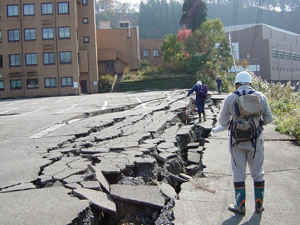
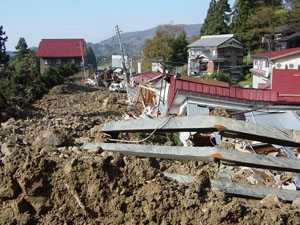
Yanakoshi Village Office The houses were destroyed
by land slide caused by the earthquake.
Tue Oct 26
Extremely big earthquake struke my city, Tohkamachi, on October 23,
2004. The first big wave came at 5:56pm with an intensity of 6- in my city
on the Japanese seven-stage seismic scale, the second 6:34pm with an intensity
of 6+.
An intensity of 6- : it is difficult to stand on your feet.
An intensity of 6+: you cannot stand on your feet and you can move
by crawling on your hands and knees.
My office: Tohkamachi Experimental
Station, Forestry &
Forest products Research Institute (Japanese only)
Headquaters
(English)


My Office: my desk is in fromt of the window sade. You can see
a copy machine.
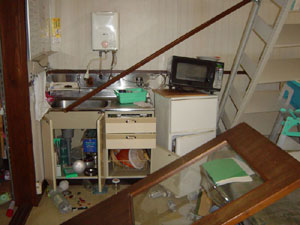
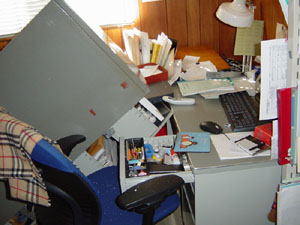
A sliding door was fallen.
My coworker's desk.

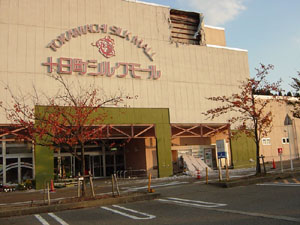
Japanese Army supplies water. A wall of the
shopping mall was destroyed.

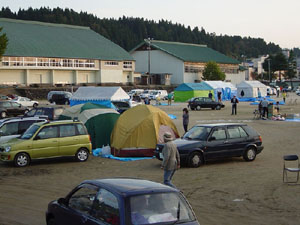
Many
people are evacuated to a playground in a school.
As a magnitude the first wave was the strongest: M6.8. To date 26
died and thousands of people were injured. This disaster has been named
ethe Mid Niigata prefecture Earthquake in 2004f.
The bullet train eShin-kansenf from Tokyo to Niigata got derailed
for the first time during its service that was running some 200km/hour.
Fortunately, no one in the train was injured.
I was home and blown out by the third wave and got a scratch on my
right elbow. All the people intimate with me were safe. My residence
and my office building were safe, but the earthquake made a mess of everything
inside the buildings. I was shocked because the Plaque of the Edgar Wilson
Award was fallen and got a slight damage. I would have died, if I had
been in my office at the time of the earthquake.
Aftermath is still continues and the Seismology Agency says the possibility
of big aftershock with an intensity of 6 by Thursday is about 30%. Some
people, I also, have slept in the car at night for safety since the disaster,
and others have in a gymnasium of school or a public hall even if the
house building is not damaged. Over 100,000 people are evacuated today
in the region including my city.
In my house power and water supply have already recovered and the
gas is available. This is exceptional, however, water has not yet supplied
for some 10,000 households, which is around 80% of all the households in
my city.
I comet hunted at the dawn on October 24, because the power failure
occurred in more than 290,000 households in the region and the sky was
very dark. I think I will not be able to see such a dark sky near my house
in the future.
more photos on the earthquake
http://www.sankei.co.jp/databox/eq_niigata/photos.html
Thu Oct 7
There was the last quarter Moon in the dawn sky but transparency
was pretty good. The forecast had released the dense fog advisory, but
it seemed no symptom of it.
When I was assembling my 18h telescope I noticed the battery of
the light was consumed. I changed it and turned the light on. Then, the
light bulb had burned out! I changed it and pulled myself together to
search.
I began to comet hunt at 3:08am from Sirius and moved my telescope
eastward. Part of the sky was covered with cloud and sometimes it obscured
the field that I seek. Even so I enjoyed the beauty of the sky. Many open
clusters, large or small and dense and sparse, and stars in the winter
Milky Way were twinkling with high contrast in the field. The planetary
nebula NGC 2438 that is in M46 was easy to detect under this condition.
Gradually I felt that heart was lost from my body during the searching
session. I had winter boots on and wore winter coat. Autumn has come.
After one hour searching SE sky was clouded and I trained my telescope
on the north. Soon after that the twilight began and I saw the Leo with
the Venus rose majestically.
Tue Sep 27
Around two weeks ago, I have received an e-mail from Don Machholz,
a discoverer of C/2004 Q2 Machholz. He greeted me and gave me some informed
on comet discovery: he read my papers gCan comet hunters survive?h on
my web page and commented on them.
He told me that in 1967-8, Dr. Edgar Everhart wrote an article
for the Astronomical Journal, which explains the reason why comet discovery
rate is higher in the morning sky than in the evening sky, and that Don
found that comets discovered in the morning sky are about a magnitude
brighter then those found in the evening sky.
Luckily enough I learned those findings in my late teen from Tsutomu
Sekifs publications. One of them was issued in the late 1960fs! I read
it more than 20 years ago and I replied Don so.
This made me realize that how Sekifs books encouraged us, Japanese
comet hunters. Quite a few people were stimulated by him and his books,
and began to comet hunting. I am one of them and cannot help admiring
Sekifs contribution to the Japanese comet society, which made Japan one
of the most comet discovery countries in the world.
Sun Sep 12
Last evening and this morning, I have enjoyed comet hunting since
13 August. It had been depressing weather on top of being busy.
Last evening, first of all, I observed C/2001 Q4 NEAT that faded
to 10 th magnitude. Then, I began to seek from Orphiuchus to Saggitarius.
Transparency was pretty good with a soft wind: it was a comfortable hunting
in the Milky Way. I caught more than 30 of clusters and nebulae, most
of them were globular clusters. Some of them were very impressive, for
example M10, M12 and M22. They include tens of thousands or hundreds of
thousands stars and have been shining for about 10 billion years, almost
the same with the age of our universe!
NGC6445, planetary nebula in Sgr, was not detected by gIdentify
modeh of NGC max digital setting circles, because the brightness of
this object was not registered in the computer and described as gunknownh
in the list. But you can find it in the catalogue of NGC max and can
introduce it. I confirmed this object using the Uranometria 2000 star atlas.
I slept in my car and got up at 2:10am, however, I could only
see a few stars among the gap of cloud. At 3am, one hour before the
beginning of the twilight, a starry sky began to spread and I started
to comet hunting. Contrary to last evening the wind was fairly strong
that prevented the smooth motion of my telescope and bothered me. This
is the one of the defects of the Dobsonian telescope. Even such bad condition
I caught some dark galaxies, 12 th magnitude, in Eri due to clear sky.
Actually, I had printed star charts to observe brightness of some
comets: C/2004 Q1 Tucker, C/2004 Q2 Machholz and C/2004 R2 ASAS. However,
I could not do it because of cloud and lack of time. The only comet
I saw among the three was C/2004 Q2 Machholz: it had high degree of concentration
(DC) of 6 and 10 th magnitude. It was reported as 11 th maginitude at
the discovery. However, you could find this image with ease if you use
a telescope of 15 cm or more.
Sun Aug 29
Machholz (USA) made a visual discovery of a new comet (C/2004
Q4) with a 15 cm reflector 30x on Aug 27 UT! Congratulations! I believe
this discovery encourages visual comet hunters.
I did not get up in the morning of Aug 27 because it must be
cloudy. I tried to observe it and got up today and yesterday, however,
I was clouded out on the both days. He estimated it as 11 th magnitude,
it means his site is very dark; an 11th magnitude comet cannot be discovered
with 15 cm at my observing site.
I have comet hunted only three times in this month due to bad
weather and being busy.
Wed Aug 4
I went on a one day hike to a mountain last Sunday. That mountain,
Kanayama 2245 m above sea level which is located at the boundary between
Niigata prefecture and Nagano prefecture, is famous for its beauty
of an alpine plant. I uploaded some
of the pictures (these photos might be deleted without notice).
For this dusk searching session wind was very strong and I
could not assemble 18 inch telescope. Instead I used 8 inch reflector.
Before I began to search I saw C/2001 Q4 NEAT and C/2003 K4 LINEAR.
However, I caught both of them during the comet hunting session again.
Tue Jul 27
I have swept the predawn sky since June 19. It had been bad
weathercprobably except July 22 and 23. However, I was not in my home
on those days.
I have attended the mirror polishing class that was held at
the Sundai Gakuen Senior High School, Tokyo from July 22 to 25. A
mentor was Kaoru Ikeya who is a legendary comet hunter at the same time
a professional telescope mirror maker.
 @I am grinding a 6 inch mirror.
@I am grinding a 6 inch mirror.
Atsuyoshi Nishina who had@advised me to make an 18 inch telescope
recommended me to anticipate in the class. Twenty six years has passed
since I have ever polished a mirror last. There were 36 participants
but only several of them including me could complete the mirrors in
the four days.
I polished a 6 inch F6 mirror. For me it was incredible to
make such an excellent mirror! It is 0.0173 Lambda, that is 1/58 Lambda.
The result of Foucault test is here.
Tue Jul 13
Four weeks have passed since I comet hunted last. It has
been cloudy or rainy though there were some cloudless days with low
transparency.
A few days ago, a starry night was expected and I set up
the alarm clock and tried to get up. But I could not. I do not know
if the clock beeped or not. I might stop it unconsciously because I
got tired due to the field trip for scientific research on that day.
I do not know if the sky was clear at the dawn.
The forecast says it would be cloudy the coming week.
Where the clear sky is? I eager to comet hunt!
Sun June 13
I returned from Paris on Thursday June 10. I still do not
feel well due to jet lag.
The IWCA was fruitful and I was very satisfied to meet
with Doug Snyder and his wife Jean, to observe the Venus transit and
to enjoy tourism in France. Some pictures of the workshop are on the
websites:
http://astrosurf.com/comet/IWCA3/IWCA3.html
http://www.planetastronomy.com/special/IWCA%20report%20juin%202004-engl.htm
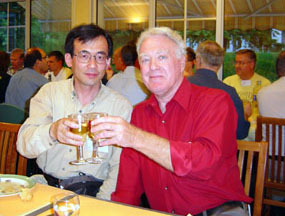
I also took some photos but here I post one with Doug.
I will upload more of them on my website near future.
Though I did not apply for presentation in advance, I could
give a 10 minutes presentation titled gVisual comet hunting under NEO
surveysh with a permission of the organizer. The content is mainly
based on the article gCan comet hunters survive? No. 3h and a personal
communication with Kazimieras Cernis, a Lithuanian comet hunter, on the
analysis of comet discovery.
After my presentation Sebastian Höenig said that my prospect
for visual discovery was too optimistic and that the chance of visual
discovery was 1% in the future. I replied that his opinion was too
pessimistic. We do not know what actually happens but I believe that
we have still enough possibility for visual discoveries.
After the workshop we went on Venus transit observation
tour for Montbeliard, more than 400 km east of Paris near the boarder
of Switzerland, where the weather condition was expected to be best.
Philippe Morel, a vice president of SAF (Société Astronomique de France)
organized the tour and he himself drove us to the site. He is an amateur
astronomer but I cannot imagine an amateur is assigned to a vice president
of Japanese Astronomical Society. The sky was clear all the day and
we could observe the phenomenon successfully. I saw gblack droph
at the second and the third contact by visual observation and Doug
also. Other observers said they observed it visually, however, two
observers including Philippe did not with videos.
I admire efforts of all the people who concerned with organizing
the observation tour, especially Philippe.
Tue May 25 – Wed May 26
In the evening on May 25 I drove to the observing site
where an altitude is 1100 m. I planed to sleep in my car after arrival
and would comet hunt at the predawn. However, the sky was too clear
to sleep even though there was a crescent moon in the western sky.
I assembled 110 mm binocular and swept the sky for 45
minutes. C/2001 Q4 NEAT has a tail of three degrees long that was
the type I tail and the type II was also apparent. I searched about
40x120 square degrees. Then, I tried to sleep but suddenly strong wind
began to blow. It whizzed and again I could not sleep well!
On May 26 I got up at 1:10am. The Milky Way was very bright
as if it had been cloud and I saw comet like M13 by naked eye. However,
the night sky in my boyhood was much darker, I remembered.
I comet hunted one hour and 35 minutes by 18h and after
that 25 minutes by 110mm binocular. During this comet hunting session
I caught two impressive objects with 18h: Cocoon Nebula (IC5146) and
NGC404, 6.5f NW of 2nd magnitude star Beta Andromeda.
e May 14 - Sat May 15
How lucky it is to have clear sky today! The weather
began to recover before evening. I drove about one hour for good
observing site: 1100 m above sea level. During the twilight I could
see C/2001 Q4 NEAT with a few degrees of tail by naked eye. It was as
bright as M44.
After one hour and twenty minutes comet searching session,
I enjoyed observing Q4 NEAT and some Messier Objects and made a sketch of Q4 NEAT. This comet
has three tails!
Saturday
I slept for two hours and half in my car and got up at
1:30am. I enjoyed comet hunting at predawn and watched C/2003 T3
Tabor for the first time: it was at a low altitude, about 10 degrees,
with 9th magnitude. I felt I could discover this image with my 18h because
of good transparency and high degree of concentration: DC: 7.
C/2004 F4 Bradfield was still bright. The tail length
was 0.5 degrees. The image of this comet observed by my 18h 68x is
similar to that of Q4 NEAT seen by 8x50 mm binocular at the last dusk.
On my way home, thin cloud spread over the sky. It has been fine only
at the night time!
Wed May 12
I have observed C/2001 Q4 NEAT on May 5 and 6. It was
4th magnitude with a short tail. It is disappointed that both C/2001
Q4 NEAT and C/2002 T7 LINEAR are much darker than expected. However,
I was excited to see the long tail of the C/2004 F4 Bradfield last month!
After I saw Q4, it has been cloudy and we cannot expect
clear sky for the coming one week.
I will attend the third International Workshop on Cometary
Astronomy (IWCA III)
held at Paris next month. In Paris I will meet with Doug Snyder,
a co-discoverer of C/2002 E2 Snyder-Murakami! I will leave Japan on
May 31 with Akimasa Nakamura and Takaaki Oribe.
Thurs Apr 29
How impressive the long tail of C/2004 F4 Bradfield
is! The bad weather has continued for one week and finally, this
morning, I could see the comet. The tail extended to more than eight
degrees by the observation of my 15x110mm binocular
under the excellent sky condition. The nucleus of the comet was
star like and small, however, the feature of long tail looks like
the Comet Ikeya-Seki that I see only in photos. I could recognize
the elongated image of the comet by naked eye!
C/2002 T7 LINEAR was much brighter than C/2004 F4 but
its tail was much shorter: one degree. C/2002 T7 was located at very
low altitude in the twilight and I could not see it by naked eye.
I could not afford to assemble my 18h Dobsonian at
this predawn and I comet hunted with 110 mm binocular for 45 minutes.
Wed April 21
How wonderful the clearness of the sky at this predawn
was! Both the scintillation and the transparency were good and light
pollution from the ski fields have disappeared since they were closed.
The efficiency of the comet hunting becomes high under such a nice
condition. Of course, this is partly due to an excellent optics,
on top of the good sky. All the stars showed pinpoint images. I scanned
from the upper edge of the telescope field to the lower edge in two
second or shorter. The actual field of view is 1.3 degree with 68x.
Even such high scanning speed, I think I caught all
the nebulae that I expected to catch. Humanfs eye has high performance.
However, the only obstacle that I have to worry about
is the shortage of sleep. I have to get up at 1:30am to enjoy comet
hunting. Toward the summer solstice the time I must get up becomes
earlier than now.
C/2002 T7 LENEAR is at the predawn but I have not
seen it because it is very low altitude in the twilight. C/2004
F4 Bradfield is also the same situation.
This was the seventh hunting session in this month.
Thurs Apr 1
Spring has come! Today, sow has disappeared at the
meteorological station in my workplace. Bai (yellow fine sand
from China) deteriorates transparency, but I can drive hills,
mountainous area and rice farm that were covered with snow and inaccessible
in winter.
I can sleep with ease for a week from today because
it is almost full moon and I do not comet hunt.
Erratum
Wrong: on Mar 28 I wrote eI paid attention
to C/2003 H1 LENEARf.
Correct: C/2003 K4 LINEAR
Sun 28 Mar
There are many clear days in this month. I searched
Cygnus and Vulpecula mainly this morning. I paid attention to
C/2003 H1 LENEAR, 12th magnitude, but could not catch it during
this comet hunting session. After passing though the position of that
comet I moved my 18ff toward the position of that comet to confirm
it, however, could not recognize it at 68x.
I referred to the chart of the comet that I printed
out last night, then, I could detect the comet. It was too small
to catch at 68x, though it was bright enough. The diameter was 0.3f
by intuition; probably the outer coma was faint and not seen for
me. It became clear at 170x and the tail was also seen at this magnification.
Sat 20 to Sun 21 Mar
I took part in the Messier Marathon held at Hozu
cattle farm, 100 km north east of Tokyo. Several decades of runners
entered. I used 20 cm reflector as a main instrument, 18ff Dobsonian
and 7x50 mm binocular.
Unfortunately, it was cloudy until 8pm and we could
not observe M74, 77, 33, 31, 31 and 110. From 8pm to 9pm it was
clear but after that we had a little snow. After midnight the weather
recovered though wind was rather strong.
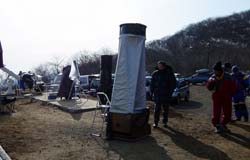 Messier marathon at Kozu cattle farm
Messier marathon at Kozu cattle farm
I could observe 103 Messier objects and this was
the highest record among the participants. Seven objects were
missed: M30 that rose one hour before sunrise, and six evening objects
that were impossible to see due to cloud. M72, 73, 2, 15, 75 and
55 were difficult because of light pollution and I used 18ff Dobsonian
to observe those objects.
I enjoyed chatting about star watching gears with
many astronomers. It was interesting to compare the power of telescopes:
40 cm (16ff), my 46 cm (18ff) and 50 cm (20ff). @We saw M51 and
M101 to compare them. The difference between 40 cm and 46 cm was
not so much, but 46 cm and 50 cm was apparent.
Sun Mar 13
In this morning I went to comet hunting but it
began to snow after 10 minutes searching! I thought it would stop
soon but it was getting stronger with time. I extended big eblue sheetf
and covered my 18f Dobsonian with it for break down. Bad luck!
Last week end, Mar 6-7, I attended 34th Comet
Conference held in Nagano Prefecture. There are 84 attendees including
both armature and professional astronomers.
I met two comet discoverers, Tsuruhiko Kiuchi
and Yoshimi Ichimura, though Kiuchi stayed the venue only about
one hour because of his work. Several attendees try to or plan
to comet hunt besides Ichimura and me and had fruitful discussion
on comet hunting.
The most impressive presentation for me was taken
by Toshimi Taki, entitled eCan visual comet hunting compete
with NEO sky surveys?f He produced 3000 comets in a computer
using Monte-Carlo simulation and discussed possibility of comet
discovery for both NEO surveys and visual comet hunters. The result
showed that the chance of discovery reduced to one quarter in northern
hemisphere while to half in southern hemisphere after NEO operation.
His simulation includes a lot of results and will be published in the
future.
There is good news for comet hunters. Akimasa
Nakamura told me that LINEAR project finishes in five years and
that Pan-STARRS (a new NEO survey system) may be rejected because
of financial problem. He said he got the information from comet
–ml but it was new for me since I am not a member of that mailing
list.
Is our future rosy? Any way letfs go on comet
hunting.
Weds Feb 25
There are many clear nights considering in this
season in this area and I comet sought four times since February
21 at predawn! Temperature was quite high but the sky was clear.
Therefore, I enjoyed comfortable comet hunting at predawn.
I purchased Russian 15x110 mm binocular and used
it a couple of times for this weekfs comet hunting. I will update
its images near future.
Tohkamachi
Snow Festival was held last weekend in my city Tohkamachi
and we created snow statue of eTonari-no Totorof in my workplace
as shown.
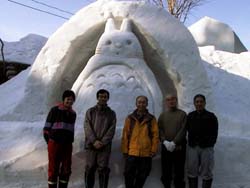
Sat Feb 14
At last I could enjoy clear sky at dusk of Feb
10 and at predawn of Feb 11, though in the latter the Moon was
bright. I was waiting for clear sky patiently for more than one
month.
At this predawn the Moon just after the last
quarter was still bright but I was satisfied with the gorgeous
stars in Ophiuchus and Aquila. I caught only a couple of open clusters,
however, they looked much more brilliant and clearer than usual at
this predawn.
Sun Feb 1
I left for my house at 3am under clear sky.
Again! Cloud began to spread over the sky when I arrived at the
observing site. However, the situation was different at this
dawn: there were some breaks in the clouds.
I assembled my telescope and waited for a while.
I comet hunted through a small gap in the clouds for 10 minutes
or so, and then the gap disappeared. I waited another 10 minutes
to wait for a gap formation. I repeated such a process, and total
searching time reached 50 minutes. Satisfactory!
While I was waiting for a formation of breaks
in the clouds, I looked up the sky: Leo looked in a dignified
manner in the gap in the clouds with Jupiter, the king of the planet,
at his foot, although he declined westward. Usually, Leo seems to
be miserable when he declines but this time, unexpectedly, I saw
very majestic Leo! I was influenced by him. Leo at this dawn gave me
energy to continue comet hunting and satisfaction even under such bad
sky condition.
Thurs Jan 22
I got up at 5am and could see stars only near
the zenith through my apartment window. I stayed up until 5:30am,
when twilight began, but the situation was the same.
This was the third time in this week that
I felt such kind of frustration.
On Sunday Jan 18 I left for comet hunting
under clear sky at 3am, however, when I arrived at the observing
site the sky was completely covered with cloud. I waited for
half an hour but in vain.
On Wednesday 21 I got out of bed at 3:20 and
started from home under clear sky. Arriving at the observing
site, cloud occupied about 80% of the sky. After an hour I left
for the observing site to my home.
I spent only 20 minutes for comet hunting
in this month.@In winter this kind of bad weather is typical
in Japan Sea side area.
Sat Jan 10
It was very fine and cold at this dawn.
However, I did not comet hunted due to the bright moon. I
did it once this year, but it was only 20 minutes because it
clouded out. I believe the weather will not have been good over
one week from today as the forecast says.
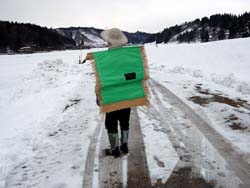
I saw my one of my neighbors walking in
front of my apartment with traditional wear of Niigata Prefecture
eKigoza and Kasaf; a woven mat and hat of rushes. This is a traditional
rain and snow wear.
Top of this page










 @I am grinding a 6 inch mirror.
@I am grinding a 6 inch mirror. Messier marathon at Kozu cattle farm
Messier marathon at Kozu cattle farm
